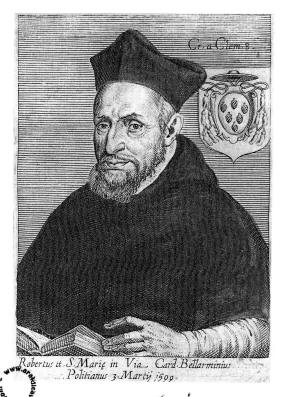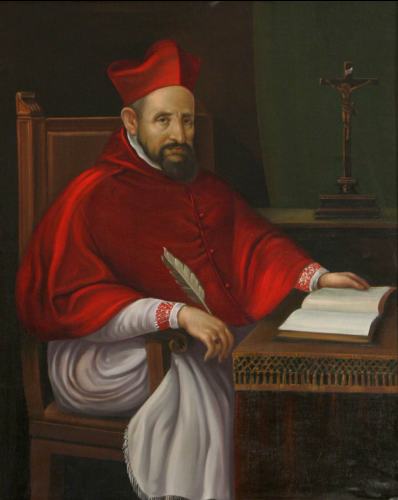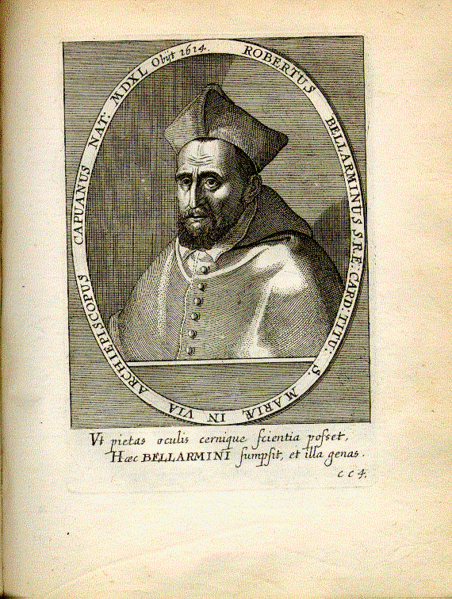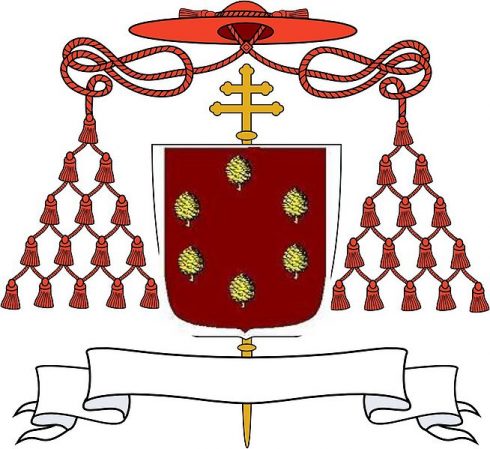St. Robert Francis Romulus Bellarmine
(Also, “Bellarmino”).
A distinguished Jesuit theologian, writer, and cardinal, born at Montepulciano, 4 October, 1542; died 17 September, 1621.
His father was Vincenzo Bellarmino, his mother Cinthia Cervini, sister of Cardinal Marcello Cervini, afterwards Pope Marcellus II. He was brought up at the newly founded Jesuit college in his native town, and entered the Society of Jesus on 20 September, 1560, being admitted to his first vows on the following day. The next three years he spent in studying philosophy at the Roman College, after which he taught the humanities first at Florence, then at Mondovi. In 1567 he began his theology at Padua, but in 1569 was sent to finish it at Louvain, where he could obtain a fuller acquaintance with the prevailing heresies. Having been ordained there, he quickly obtained a reputation both as a professor and a preacher, in the latter capacity drawing to his pulpit both Catholics and Protestants, even from distant parts. In 1576 he was recalled to Italy, and entrusted with the chair of Controversies recently founded at the Roman College. He proved himself equal to the arduous task, and the lectures thus delivered grew into the work “De Controversiis” which, amidst so much else of excellence, forms the chief title to his greatness. This monumental work was the earliest attempt to systematize the various controversies of the time, and made an immense impression throughout Europe, the blow it dealt to Protestantism being so acutely felt in Germany and England that special chairs were founded in order to provide replies to it. Nor has it even yet been superseded as the classical book on its subject-matter, though, as was to be expected, the progress of criticism has impaired the value of some of its historical arguments.

St. Aloysius Gonzaga. His father furnished him with little guns, and other weapons, took him to Casal to show him a muster of three thousand Italian foot, and was much delighted to see him carry a little pike, and walk before the ranks.
In 1588 Bellarmine was made Spiritual Father to the Roman College, but in 1590 he went with Cardinal Gaetano as theologian to the embassy Sixtus V was then sending into France to protect the interests of the Church amidst the troubles of the civil wars. Whilst he was there news reached him that Sixtus, who had warmly accepted the dedication of his “De Controversiis”, was now proposing to put its first volume on the Index. This was because he had discovered that it assigned to the Holy See not a direct but only an indirect power over temporals. Bellarmine, whose loyalty to the Holy See was intense, took this greatly to heart; it was, however, averted by the death of Sixtus, and the new pope, Gregory XIV, even granted to Bellarmine’s work the distinction of a special approbation. Gaetano’s mission now terminating, Bellarmine resumed his work as Spiritual Father, and had the consolation of guiding the last years of St. Aloysius Gonzaga, who died in the Roman College in 1591. Many years later he had the further consolation of successfully promoting the beatification of the saintly youth. Likewise at this time he sat on the final commission for the revision of the Vulgate text. This revision had been desired by the Council of Trent, and subsequent popes had laboured over the task and had almost brought it to completion. But Sixtus V, though unskilled in this branch of criticism, had introduced alterations of his own, all for the worse. He had even gone so far as to have an impression of this vitiated edition printed and partially distributed, together with the proposed Bull enforcing its use. He died, however, before the actual promulgation, and his immediate successors at once proceeded to remove the blunders and call in the defective impression. The difficulty was how to substitute a more correct edition without affixing a stigma to the name of Sixtus, and Bellarmine proposed that the new edition should continue in the name of Sixtus, with a prefatory explanation that, on account of aliqua vitia vel typographorum vel aliorum which had crept in, Sixtus had himself resolved that a new impression should be undertaken. The suggestion was accepted, and Bellarmine himself wrote the preface, still prefixed to the Clementine edition ever since in use. On the other hand, he has been accused of untruthfulness in stating that Sixtus had resolved on a new impression. But his testimony, as there is no evidence to the contrary, should be accepted as decisive, seeing how conscientious a man he was in the estimation of his contemporaries; and the more so since it cannot be impugned without casting a slur on the character of his fellow-commissioners who accepted his suggestion, and of Clement VIII who with full knowledge of the facts gave his sanction to Bellarmine’s preface being prefixed to the new edition. Besides, Angelo Rocca, the Secretary of the revisory commissions of Sixtus V and the succeeding pontiffs, himself wrote a draft preface for the new edition in which he makes the same statement: (Sixtus) “dum errores ex typographiâ ortos, et mutationes omnes, atque varias hominum opiniones recognoscere cœpit, ut postea de toto negotio deliberare atque Vulgatam editionem, prout debebat, publicare posset, morte præventus quod cœperat perficere non potuit”. This draft preface, to which Bellarmine’s was preferred, is still extant, attached to the copy of the Sixtine edition in which the Clementine corrections are marked, and may be seen in the Biblioteca Angelica at Rome.
In 1592 Bellarmine was made Rector of the Roman College, and in 1595 Provincial of Naples. In 1597 Clement VIII recalled him to Rome and made him his own theologian and likewise Examiner of Bishops and Consultor of the Holy Office. Further, in 1599 he made him Cardinal-Priest of the title of Santa Maria in viâ, alleging as his reason for this promotion that “the Church of God had not his equal in learning”. He was now appointed, along with the Dominican Cardinal d’Ascoli, an assessor to Cardinal Madruzzi, the President of the Congregation de Auxiliis, which had been instituted shortly before to settle the controversy which had recently arisen between the Thomists and the Molinists concerning the nature of the concord between efficacious grace and human liberty. Bellarmine’s advice was from the first that the doctrinal question should not be decided authoritatively, but left over for further discussion in the schools, the disputants on either side being strictly forbidden to indulge in censures or condemnations of their adversaries. Clement VIII at first inclined to this view, but afterwards changed completely and determined on a doctrinal definition. Bellarmine’s presence then became embarrassing, and he appointed him to the Archbishopric of Capua just then vacant. This is sometimes spoken of as the cardinal’s disgrace, but Clement consecrated him with his own hands—an honour which the popes usually accord as a mark of special regard. The new archbishop departed at once for his see, and during the next three years set a bright example of pastoral zeal in its administration.
 In 1605 Clement VIII died, and was succeeded by Leo XI who reigned only twenty-six days, and then by Paul V. In both conclaves, especially that latter, the name of Bellarmine was much before the electors, greatly to his own distress, but his quality as a Jesuit stood against him in the judgment of many of the cardinals. The new pope insisted on keeping him at Rome, and the cardinal, obediently complying, demanded that at least he should be released from an episcopal charge the duties of which he could no longer fulfil. He was now made a member of the Holy Office and of other congregations, and thenceforth was the chief advisor of the Holy See in the theological department of its administration. Of the particular transactions with which his name is most generally associated the following were the most important: The inquiry de Auxiliis, which after all Clement had not seen his way to decide, was now terminated with a settlement on the lines of Bellarmine’s original suggestion. 1606 marked the beginning of the quarrel between the Holy See and the Republic of Venice which, without even consulting the pope, had presumed to abrogate the law of clerical exemption from civil jurisdiction and to withdraw the Church’s right to hold real property. The quarrel led to a war of pamphlets in which the part of the Republic was sustained by John Marsiglio and an apostate monk named Paolo Sarpi, and that of the Holy See by Bellarmine and Baronius. Contemporaneous with the Venetian episode was that of the English Oath of Alliance. In 1606, in addition to the grave disabilities which already weighed them down, the English Catholics were required under pain of prœmunire to take an oath of allegiance craftily worded in such wise that a Catholic in refusing to take it might appear to be disavowing an undoubted civl obligation, whilst if he should take it he would be not merely rejecting but even condemning as “impious and heretical” the doctrine of the deposing power, that is to say, of a power, which, whether rightly or wrongly, the Holy See had claimed and exercised for centuries with the full approval of Christendom, and which even in that age the mass of the theologians of Europe defended. The Holy See having forbidden Catholics to take this oath, King James himself came forward as its defender, in a book entitled “Tripoli nodo triplex cuneus”, to which Bellarmine replied in his “Responsio Matthfi Torti”. Other treatises followed on either side, and the result of one, written in denial of the deposing power by William Barclay, an English jurist resident in France, was that Bellarmine’s reply to it was branded by the Regalist Parlement of Paris. Thus it came to pass that, for following the via media of the indirect power, he was condemned in 1590 as too much of a Regalist and in 1605 as too much of a Papalist.
In 1605 Clement VIII died, and was succeeded by Leo XI who reigned only twenty-six days, and then by Paul V. In both conclaves, especially that latter, the name of Bellarmine was much before the electors, greatly to his own distress, but his quality as a Jesuit stood against him in the judgment of many of the cardinals. The new pope insisted on keeping him at Rome, and the cardinal, obediently complying, demanded that at least he should be released from an episcopal charge the duties of which he could no longer fulfil. He was now made a member of the Holy Office and of other congregations, and thenceforth was the chief advisor of the Holy See in the theological department of its administration. Of the particular transactions with which his name is most generally associated the following were the most important: The inquiry de Auxiliis, which after all Clement had not seen his way to decide, was now terminated with a settlement on the lines of Bellarmine’s original suggestion. 1606 marked the beginning of the quarrel between the Holy See and the Republic of Venice which, without even consulting the pope, had presumed to abrogate the law of clerical exemption from civil jurisdiction and to withdraw the Church’s right to hold real property. The quarrel led to a war of pamphlets in which the part of the Republic was sustained by John Marsiglio and an apostate monk named Paolo Sarpi, and that of the Holy See by Bellarmine and Baronius. Contemporaneous with the Venetian episode was that of the English Oath of Alliance. In 1606, in addition to the grave disabilities which already weighed them down, the English Catholics were required under pain of prœmunire to take an oath of allegiance craftily worded in such wise that a Catholic in refusing to take it might appear to be disavowing an undoubted civl obligation, whilst if he should take it he would be not merely rejecting but even condemning as “impious and heretical” the doctrine of the deposing power, that is to say, of a power, which, whether rightly or wrongly, the Holy See had claimed and exercised for centuries with the full approval of Christendom, and which even in that age the mass of the theologians of Europe defended. The Holy See having forbidden Catholics to take this oath, King James himself came forward as its defender, in a book entitled “Tripoli nodo triplex cuneus”, to which Bellarmine replied in his “Responsio Matthfi Torti”. Other treatises followed on either side, and the result of one, written in denial of the deposing power by William Barclay, an English jurist resident in France, was that Bellarmine’s reply to it was branded by the Regalist Parlement of Paris. Thus it came to pass that, for following the via media of the indirect power, he was condemned in 1590 as too much of a Regalist and in 1605 as too much of a Papalist.
 Bellarmine did not live to deal with the later and more serious stage of the Galileo case, but in 1615 he took part in its earlier stage. He had always shown great interest in the discoveries of that investigator, and was on terms of friendly correspondence with him. He took up too—as is witnessed by his letter to Galileo’s friend Foscarini—exactly the right attitude towards scientific theories in seeming contradiction with Scripture. If, as was undoubtedly the case then with Galileo’s heliocentric theory, a scientific theory is insufficiently proved, it should be advanced only as an hypothesis; but if, as is the case with this theory now, it is solidly demonstrated, care must be taken to interpret Scripture only in accordance with it. When the Holy Office condemned the heliocentric theory, by an excess in the opposite direction, it became Bellarmine’s official duty to signify the condemnation to Galileo, and receive his submission. Bellarmine lived to see one more conclave, that which elected Gregory XV (February, 1621). His health was now failing, and in the summer of the same year he was permitted to retire to Sant’ Andrea and prepare for the end. His death was most edifying and was a fitting termination to a life which had been no less remarkable for its virtues than for its achievements.
Bellarmine did not live to deal with the later and more serious stage of the Galileo case, but in 1615 he took part in its earlier stage. He had always shown great interest in the discoveries of that investigator, and was on terms of friendly correspondence with him. He took up too—as is witnessed by his letter to Galileo’s friend Foscarini—exactly the right attitude towards scientific theories in seeming contradiction with Scripture. If, as was undoubtedly the case then with Galileo’s heliocentric theory, a scientific theory is insufficiently proved, it should be advanced only as an hypothesis; but if, as is the case with this theory now, it is solidly demonstrated, care must be taken to interpret Scripture only in accordance with it. When the Holy Office condemned the heliocentric theory, by an excess in the opposite direction, it became Bellarmine’s official duty to signify the condemnation to Galileo, and receive his submission. Bellarmine lived to see one more conclave, that which elected Gregory XV (February, 1621). His health was now failing, and in the summer of the same year he was permitted to retire to Sant’ Andrea and prepare for the end. His death was most edifying and was a fitting termination to a life which had been no less remarkable for its virtues than for its achievements.
His spirit of prayer, his singular delicacy of conscience and freedom from sin, his spirit of humility and poverty, together with the disinterestedness which he displayed as much under the cardinal’s robes as under the Jesuit’s gown, his lavish charity to the poor, and his devotedness to work, had combined to impress those who knew him intimately with the feeling that he was of the number of the saints. Accordingly, when he died there was a general expectation that his cause would be promptly introduced. And so it was, under Urban VIII in 1627, when he became entitled to the appellation of Venerable. But a technical obstacle, arising out of Urban VIII’s own general legislation in regard to beatifications, required its prorogation at that time. Though it was reintroduced on several occasions (1675, 1714, 1752, and 1832), and though on each occasion the great preponderance of votes was in favour of the beatification, a successful issue came only after many years. This was partly because of the influential character of some of those who recorded adverse votes, Barbarigo, Casante, and Azzolino in 1675, and Passionei in 1752, but still more for reasons of political expediency, Bellarmine’s name being closely associated with a doctrine of papal authority most obnoxious to the Regalist politicians of the French Court. “We have said”, wrote Benedict XIV to Cardinal de Tencin, “in confidence to the General of the Jesuits that the delay of the Cause has come not from the petty matters laid to his charge by Cardinal Passionei, but from the sad circumstances of the times” (Études Religieuses, 15 April, 1896).
St. Robert Bellarmine was canonized by Pope Pius XI in 1930, and declared a Doctor of the Universal Church in 1931. He is the patron saint of catechists.
A full list of Bellarmine’s writings, and of those directed against him, may be seen in Sommervogel’s “Bibliothhque de la compagnie de Jésus”. The following are the principal:
- Controversial works. “Disputationes de Controversiis Christianae Fidei adversus hujus temporis hereticos”, of the innumerable editions of which the chief are those of Ingolstadt (1586-89), Venice (1596), revised personally by the author, but abounding in printer’s errors, Paris or “Triadelphi” (1608), Prague (1721), Rome (1832); “De Exemptione clericorum”, and “De Indulgentiis et Jubilaeo”, published as monographs in 1599, but afterwards incorporated in the “De Controversiis”; “De Transitu Romani Imperii a Graecis ad Francos” (1584); “Responsio ad praecipua capita Apologiae . . . pro successione Henrici Navarreni” (1586); “Judicium de Libro quem Lutherani vocant Concordiae” (1585); four Risposte to the writings on behalf of the Venetian Republic of John Marsiglio and Paolo Sarpi (1606); “Responsio Matthaei Torti ad librum inscriptum Triplici nodo triplex cuneus” 1608); “Apologia Bellarmini pro responsi one sub ad librum Jacobi Magnae Britanniae Regis” (1609); Tractatus de potestate Summi Pontificis in rebus temporalibus, adversus Gulielmum Barclay” (1610).
- Catechetical and Spiritual Works. “Dottrina Cristiana breve”, and “Dichiarazione più copiosa della dottrina cristiana” (1598), two catechetical works which have more than once received papal approbation, and have been translated into various languages; “Dichiarazione del Simbolo” (1604), for the use of priests; “Admonitio ad Episcopum Theanensem nepotem suum quae sint necessaria episcopo” (1612); “Exhortationes domesticae”, published only in 1899, by Pére van Ortroy; “Conciones habitae Lovanii“, the more correct edition (1615); “De Ascensione mentis in Deum” (1615); “De Aeterna felicitate sanctorum” (1616); “De gemitu columbae” (1617); “De septem verbis Christi” (1618); “De arte bene moriendi” (1620). The last five are spiritual works written during his annual retreats.
- Exegetical and other works. “De Scriptoribus ecclesiasticis” (1615); “De Editione Latinae Vulgatae, quo sensu a Concilio Tridentino definitum sit ut ea pro authenticae habeatur”, not published till 1749; “In omnes Psalmos dilucida expositio” (1611). Complete editions of Bellarmine’s Opera omnia have been published at Cologne (1617); Venice (1721); Naples (1856); Paris (1870).
Ven. R. Bellarmini, S.R.E. Cardinalis, vita quam ipse scripsit (with an Appendix), written in 1613, at the request of Fathers Eudfmon Joannis and Mutius Vitelleschi, first published among the acta of the Process of Beatification 1675; republished in 1887 by DÖLLINGER AND REUSCH, with notes many of which are useful but the general tone of which is unfair and spiteful; a multitude of unpublished documents in the archives of the Vatican, Simancas, Salamanca, the Society of Jesus, etc.; Epistolœ familiares (1650); EUDAEMON JOANNIS, De pio obitu Card. Bellarmini (1621); FINALI, Esame fatto per me, that is, by the lay brother who attended him in his last sickness, MS.; lives by FULIGATI (1624; translated into Latin with additions by PETRA SANCTA, 1626) and BARTOLI, (1678); CERVINI, Imago virtutum (1625). These form the chief original material. Of derived lives the best are those by FRIZON (1708), and COUDERC (1893). See also LE BACHELET IN VACANT, Dict. de thiol. cath.; and for Bellarmine’s doctrine on papal authority, DE LA SERVIÈRE, De Jacobo Angl. Rege cum Card. R. Bellarmine . . . disputante (1900).
SYDNEY F. SMITH (Catholic Encyclopedia)












